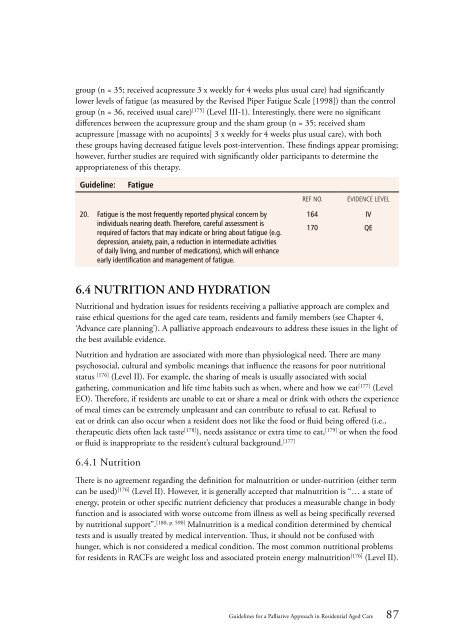Guidelines for a Palliative Approach in Residential Aged Care
Guidelines for a Palliative Approach in Residential Aged Care
Guidelines for a Palliative Approach in Residential Aged Care
Create successful ePaper yourself
Turn your PDF publications into a flip-book with our unique Google optimized e-Paper software.
group (n = 35; received acupressure 3 x weekly <strong>for</strong> 4 weeks plus usual care) had significantly<br />
lower levels of fatigue (as measured by the Revised Piper Fatigue Scale [1998]) than the control<br />
group (n = 36, received usual care) [175] (Level III-1). Interest<strong>in</strong>gly, there were no significant<br />
differences between the acupressure group and the sham group (n = 35; received sham<br />
acupressure [massage with no acupo<strong>in</strong>ts] 3 x weekly <strong>for</strong> 4 weeks plus usual care), with both<br />
these groups hav<strong>in</strong>g decreased fatigue levels post-<strong>in</strong>tervention. These f<strong>in</strong>d<strong>in</strong>gs appear promis<strong>in</strong>g;<br />
however, further studies are required with significantly older participants to determ<strong>in</strong>e the<br />
appropriateness of this therapy.<br />
Guidel<strong>in</strong>e:<br />
Fatigue<br />
Ref No.<br />
Evidence level<br />
20. Fatigue is the most frequently reported physical concern by<br />
<strong>in</strong>dividuals near<strong>in</strong>g death. There<strong>for</strong>e, careful assessment is<br />
required of factors that may <strong>in</strong>dicate or br<strong>in</strong>g about fatigue (e.g.<br />
depression, anxiety, pa<strong>in</strong>, a reduction <strong>in</strong> <strong>in</strong>termediate activities<br />
of daily liv<strong>in</strong>g, and number of medications), which will enhance<br />
early identification and management of fatigue.<br />
164<br />
170<br />
IV<br />
QE<br />
6.4 NUTRITION AND HYDRATION<br />
Nutritional and hydration issues <strong>for</strong> residents receiv<strong>in</strong>g a palliative approach are complex and<br />
raise ethical questions <strong>for</strong> the aged care team, residents and family members (see Chapter 4,<br />
‘Advance care plann<strong>in</strong>g’). A palliative approach endeavours to address these issues <strong>in</strong> the light of<br />
the best available evidence.<br />
Nutrition and hydration are associated with more than physiological need. There are many<br />
psychosocial, cultural and symbolic mean<strong>in</strong>gs that <strong>in</strong>fluence the reasons <strong>for</strong> poor nutritional<br />
status [176] (Level II). For example, the shar<strong>in</strong>g of meals is usually associated with social<br />
gather<strong>in</strong>g, communication and life time habits such as when, where and how we eat [177] (Level<br />
EO). There<strong>for</strong>e, if residents are unable to eat or share a meal or dr<strong>in</strong>k with others the experience<br />
of meal times can be extremely unpleasant and can contribute to refusal to eat. Refusal to<br />
eat or dr<strong>in</strong>k can also occur when a resident does not like the food or fluid be<strong>in</strong>g offered (i.e.,<br />
therapeutic diets often lack taste [178] ), needs assistance or extra time to eat, [179] or when the food<br />
or fluid is <strong>in</strong>appropriate to the resident’s cultural background. [177]<br />
6.4.1 Nutrition<br />
There is no agreement regard<strong>in</strong>g the def<strong>in</strong>ition <strong>for</strong> malnutrition or under-nutrition (either term<br />
can be used) [176] (Level II). However, it is generally accepted that malnutrition is “… a state of<br />
energy, prote<strong>in</strong> or other specific nutrient deficiency that produces a measurable change <strong>in</strong> body<br />
function and is associated with worse outcome from illness as well as be<strong>in</strong>g specifically reversed<br />
by nutritional support”. [180, p. 590] Malnutrition is a medical condition determ<strong>in</strong>ed by chemical<br />
tests and is usually treated by medical <strong>in</strong>tervention. Thus, it should not be confused with<br />
hunger, which is not considered a medical condition. The most common nutritional problems<br />
<strong>for</strong> residents <strong>in</strong> RACFs are weight loss and associated prote<strong>in</strong> energy malnutrition [176] (Level II).<br />
<strong>Guidel<strong>in</strong>es</strong> <strong>for</strong> a <strong>Palliative</strong> <strong>Approach</strong> <strong>in</strong> <strong>Residential</strong> <strong>Aged</strong> <strong>Care</strong> 87
















